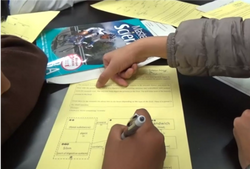
Classroom practices are essential for the teaching and learning of different subjects in secondary schools. As all types of teaching and learning practices are conducted through language in various forms of texts (e.g., interpreting the requirements or question prompts of the learning tasks and expressing the answers in appropriate language), teachers may adapt the content subject learning tasks into language-related activities so that students can not only consolidate the content knowledge but also learn the way to fulfill the learning tasks in a cognitively and linguistically appropriate way. For example, in the following classroom practice, the teacher designed the labelling game not only to help students to memorise the correct positions of different digestive organs but also to help students to revise the pronunciation and spelling of the difficult subject-specific vocabulary related to the organs.


Students are usually assigned textbook or workbook exercises but feel very difficult to answer them correctly in English even if they understand the questions and know how to answer them in their mother language. Hence, It will be very helpful for the students if teachers guide them to analyse the key question prompts and find out the corresponding text types, sentence patterns and academic vocabulary needed to answer the question. The following example shows how the teacher scaffolded students to answer the question by deconstructing the question first and then providing students with the relevant sentence patterns.

Figures and questions (left) excerpted from Mastering Science 3A (2011, p.53), Hong Kong: Oxford University Press (China) Limited, 2011



In the teaching of content (e.g. science) subjects, there are intertwining relationships between concepts which usually become learning obstacles to the students who may find the interrelationships too complicated to understand, let alone to analyse and explain them in an additional unfamiliar language. To help students overcome this difficulty, teachers may design CLIL activities by adopting pedagogical strategies such as multimodality and collaborative learning. For example, in the following Jigsaw Reading activity, the teacher untilised graphic organisers to convert texts from a verbal mode to a visual mode which facilitated students' understanding and identification of the logical relationships between different concepts.
In this Jigsaw Reading activity, the Biology teacher taught the human digestion process by guiding students to read texts, complete the corresponding graphic organisers, fill in sentences with information from the graphic organisers, and then sequence the separate sentences into coherent texts. This activity was designed to help students to focus on whole text construction by getting them to put different parts of a text together in a logical and coherent way.
To make the reading task easier, the teacher adopted the strategy of collaborative reading by dividing the text into short passages. Each passage is followed by a graphic organiser which summarises a different digestion stage. Each group was given a different passage to read and a different graphic organiser to complete. Then each group shared their graphic organiser with the whole class. In this way, all students obtained information of the entire digestion process at the end of the activity.
From the lesson scenarios, it can be seen that although learner diversity existed in terms of language proficiency and learning style, students in different classes (i.e. Class 1 and 2) were able to finish the reading and writing activities with the scaffolding from their teacher or peers. For students who were more proficient and finishing the tasks more quickly, the teacher encouraged each of them to write a text (writing independently) which explains one stage of the human digestion process. She also offered the students some suggestions, for example, to add some logical connectors to make the text more coherent, and to use academic words such as "secrete" and "neutralise" to make the text more academic and concise. To further improve this teaching design, teachers may deconstruct the sample text together with the whole class, highlighting the key stages and phases of the text structure (e.g. sequential explanation), the main sentence patterns and the academic vocabulary (esp. the subject-specific vocabulary) so that students (even those less proficient ones) may be more confident in re-writing their text independently.
By guiding students to read the texts, the teacher intended to raise their awareness of both academic content knowledge (e.g., the process of human digestion, the functions of digestive organs, and the properties of digestive juices) and academic language knowledge (e.g., the subject-specific vocabulary, the grammar and the sentence patterns that express the definitions, functions and properties of the digestive organs). The teacher also wanted to help the students to practise academic reading skills such as retrieving specific information from texts, identifying main information from key words, transferring information between verbal and visual texts, and communicating information between group members, etc.












